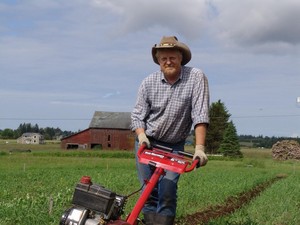26 Dec Fri 2008
My Take on Permaculture
I first heard about permaculture back in the 70's, when it was thought of as permanent + agriculture. Now, a better view is to combine permanent + culture. A couple of years ago, I was looking to add some permaculture elements to my farming, so I did a little more research. I got a copy of Permaculture in a Nutshell, 4th ed. (2005), by Patrick Whitehead, and I also went to a workshop by Toby Hemenway, author of Gaia's Garden (2001). Upon reading Whitehead's book, I quickly realized my eclectic orientation was frowned upon in the permaculture world. Right in the first chapter Whitehead lumps modern chemical agriculture and conventional organic agriculture together as both heavily dependent on fossil fuels. He then mentions a second way, peasant agriculture, which is dependent on human and beast labor. This is my style of farming. However, Whitehead then makes a false dichotomy: ". . . our only choice is between a high-energy lifestyle and one of sheer drudgery (2005:1)." His next sentence is: "But there is a third choice, called permaculture (Ibid)." Right away, I knew I had stepped into a minefield. I don't recall drudgery being such a bad state of affairs - in fact, I don't even regard long hours weeding, planting, running a tiller, harvesting, sorting, packing, washing, etc. as even drudgery. I get tired, of course, but it is a good tired. Certainly not the all-consuming drop in both physical and mental acuity faced in an office around 3:00 pm. I rather like being a tired, sweaty peasant.
Later in the Whitehead book I came across the importance of design. For example, "Organics is a method of growing, while permaculture is a design system (Ibid:67)." This is a precise statement of why I am critical of permaculture. This focus on design leads to trying to envision every obstacle and trying to prevent it or deal with it before it even comes up. In my experience, this is a fruitless pursuit, as there always seems to be something that comes up for which we are unprepared. Flexibility is thus key to dealing with each new circumstance. Adherence to design thus becomes rigidity. Some people may think I am quibbling about small matters, but let's look at an example in Rob Hopkins' Transition Handbook. Hopkins was a permaculture teacher before proposing his Transition Initiative and he gives full credit to permaculture concepts. In talking about the importance of visioning, Hopkins writes, ". . . the Transition approach has, as a fundamental principle, the belief that we can only move towards something if we can imagine what it will be like when we get there (2008:141)." I see this as quite short-sighted.
My own take on this process is to do the right thing and see what comes up - then we deal with it by doing the right thing again. This is based on how evolution by natural selection works. Small incremental changes add up to species change. This is eclecticism in a nutshell and quite opposite to permaculture, with its emphasis on human-visioned design. Evolution by natural selection has no grand design, so it is no stretch to say that permaculture is essentially anti-evolutionary. Indeed let me postulate eclecticism = evolutionary AND design = anti-evolutionary.
I checked out these ideas when I went to a workshop with Toby Hemenway in Bellingham in 2006. I asked him two key questions, the first being, "Is permaculture more like Frank Lloyd Wright's 'Form follows function,' rather than Steven Jay Gould's 'Function follows form'?" He said it was. The next question was, "Do I have to buy into the whole design concept, rather than just pick and choose methods?" He said I have to accept the whole concept - no picking and choosing. This corroborated my view of permaculture. Since I don't want to buy into the whole human-visioned design, I have basically been rejected by the permaculture designers. However, I still find occasional methods, pieces of the whole, if you will, that I find useful. One of these is the idea of key-hole beds and another is to stack functions. I think permaculture provides another vision of the future, but it is still just another strategy in my quiver of strategies.

